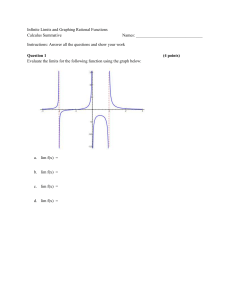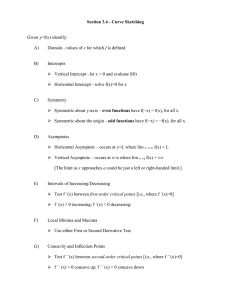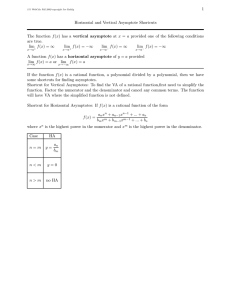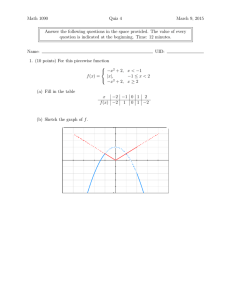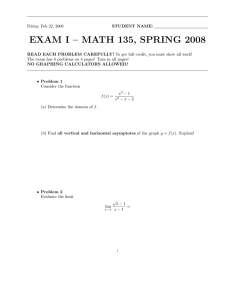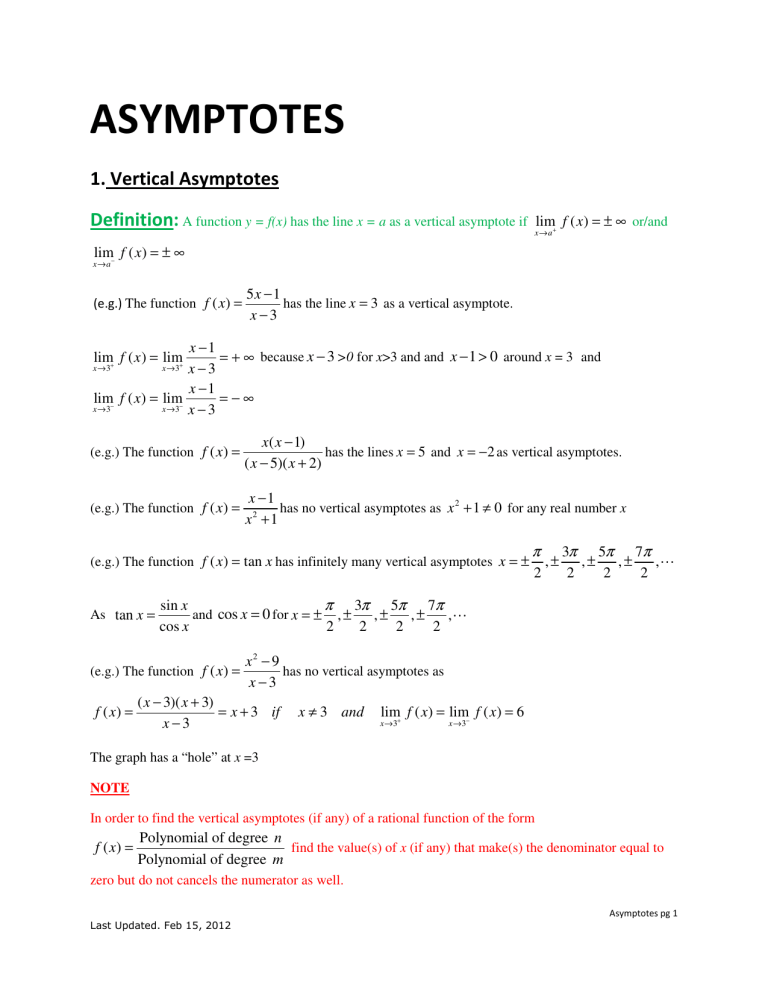
ASYMPTOTES 1. Vertical Asymptotes Definition: A function y = f(x) has the line x = a as a vertical asymptote if lim f ( x ) = ± ∞ or/and x→a+ lim f ( x ) = ± ∞ x→a− (e.g.) The function f ( x) = 5x − 1 has the line x = 3 as a vertical asymptote. x −3 x −1 = + ∞ because x − 3 >0 for x>3 and and x − 1 > 0 around x = 3 and x →3 x →3 x − 3 x −1 lim− f ( x ) = lim− =−∞ x →3 x →3 x − 3 lim+ f ( x ) = lim+ (e.g.) The function f ( x) = x( x − 1) has the lines x = 5 and x = −2 as vertical asymptotes. ( x − 5)( x + 2) (e.g.) The function f ( x ) = x −1 has no vertical asymptotes as x 2 + 1 ≠ 0 for any real number x 2 x +1 (e.g.) The function f ( x ) = tan x has infinitely many vertical asymptotes x = ± As tan x = 2 ,± 3π 5π 7π ,± ,± , 2 2 2 sin x π 3π 5π 7π and cos x = 0 for x = ± , ± ,± ,± , cos x 2 2 2 2 (e.g.) The function f ( x) = f ( x) = π x2 − 9 has no vertical asymptotes as x −3 ( x − 3)( x + 3) = x + 3 if x−3 x ≠ 3 and lim f ( x ) = lim− f ( x ) = 6 x →3+ x →3 The graph has a “hole” at x =3 NOTE In order to find the vertical asymptotes (if any) of a rational function of the form f ( x) = Polynomial of degree n find the value(s) of x (if any) that make(s) the denominator equal to Polynomial of degree m zero but do not cancels the numerator as well. Asymptotes pg 1 Last Updated. Feb 15, 2012 2. Horizontal Asymptotes Definition: A function y = f(x) has the line y =b as a horizontal asymptote if xlim f ( x ) = b and/or →+∞ lim f ( x ) = b x →−∞ Polynomial of degree n has a horizontal asymptote if Polynomial of degree m the degree of denominator is bigger or equal to the degree of numerator m ≥ n RULE A rational function of the form f ( x) = • If m > n then the line y = 0 is horizontal asymptote. • If m = n then the equation of the horizontal asymptote is y = (ratio of leading coefficients) • f ( x) | = ∞ If m < n then there is no horizontal asymptote as | xlim →±∞ (e.g) f ( x ) = 5x −1 14 has the line y = 5 (the x-axis) as horizontal asymptote because = 5+ x−3 x −3 lim f ( x ) = lim x→ ± ∞ x →±∞ 5x −1 =5 x−3 Asymptotes pg 2 Last Updated. Feb 15, 2012 5x2 − 7 5 (e.g.) The function f ( x) = 2 has the horizontal line y = as horizontal asymptote: 9x + 3 9 7 5 x 2 (1 − 2 ) 5x2 − 7 5x = 5 lim f ( x ) = lim 2 = lim x →∞ x →∞ 9 x + 3 x →∞ 3 9 x 2 (1 − 2 ) 9 9x (e.g.) The function f ( x) = 5 x3 − 3 12 x 4 + x 2 + 7 has the horizontal line y = 0 (the x-axis) as horizontal 5 x3 − 3 =0 x →∞ 12 x 4 + x 2 + 7 asymptote: lim f ( x) = lim x →∞ (e.g.) The function f ( x) = 5 x3 + 3x + 1 12 x 2 + 3 has no horizontal asymptote because: 5 x3 + 3x + 1 5 x3 + 3x + 1 = +∞ and lim f ( x ) = lim =−∞ x →∞ 12 x 2 + 3 x →−∞ x →− ∞ 12 x 2 + 3 lim f ( x ) = lim x →∞ For other (than rational) type of function apply the definition directly (e.g.) The function f ( x) = −2 x + 9 + e− x lim g ( x) = lim e x →∞ x →∞ −x y = −2 x + 9 as the horizontal asymptote because: = 0 even if lim g ( x) = lim e − x = + ∞ x →−∞ x →−∞ Asymptotes pg 3 Last Updated. Feb 15, 2012 3. Oblique Asymptotes (or Slant Asymptotes) Definition A function y = f(x) has the line y = mx+ b as a oblique (or slant) asymptote if f(x) = mx +b + g(x) and lim g ( x ) = 0 x →±∞ x2 + 1 2 = x +1+ has the line y = x + 1 oblique asymptote as x −1 x −1 2 2 becomes very small lim g ( x) = lim = 0 which means that for x “big enough “the term x →± ∞ x →± ∞ x − 1 x −1 compared to the term x + 1 and therefore f ( x ) ≈ x + 1. (e.g.1) The function f ( x) = ← y = x +1 oblique assymptote ← x = 1 vertical assymptote Note that the above function has x = 1as vertical asymptote:------- Asymptotes pg 4 Last Updated. Feb 15, 2012 5 x3 + 2 x 2 + 3 3 = 5 x + 2 + 2 has the line y = 5 x + 2 oblique asymptote as (e.g.2) The function f ( x ) = 2 x x 1 3 lim g ( x ) = lim(− 2 ) = 0 which means that for x “big enough “the term 2 becomes very small x →∞ x →∞ x +1 x compared to the term 5 x + 2 and therefore f ( x ) ≈ 5 x + 2 RULE A rational function of the form f ( x ) = Polynomial of degree n has an oblique (slant) Polynomial of degree m asymptote iff the degree of numerator is exactly one unit more than the degree of denominator Degree of numerator = 1+ degree of denominator NOTE 1. Polynomial functions f ( x ) = an x n + an −1 x n −1 + + a2 x 2 + a1 x + a0 , as well as f ( x) = sin x, f ( x ) = cos x, have no asymptotes. 2. Exponential functions f ( x ) = e kx has no vertical asymptotes but has y = 0 (x axis) as horizontal asymptote. Asymptotes pg 5 Last Updated. Feb 15, 2012 (eg) f ( x ) = e 0.1x has y = 0 (x axis) as horizontal asymptote. 3. Logarithmic functions f ( x) = log a x have only vertical asymptote x = 0 (y-axis): (e.g.) Graph of f ( x) = ln x If a >1 then lim+ log a x = − ∞ and if 0< a<1 then lim+ log a x = ∞ x →0 x →0 Asymptotes pg 6 Last Updated. Feb 15, 2012
